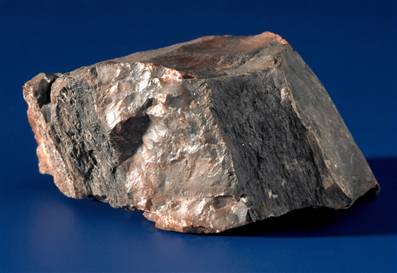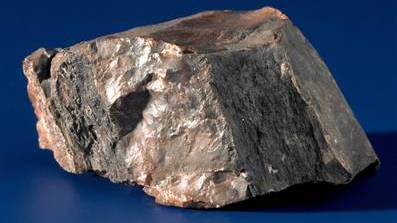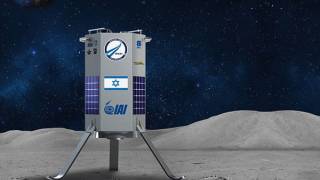Moon rocks lost in space? No, lost on Earth
Attention, countries of the world: Do you know where your moon rocks are?The discovery of a fake moon rock in the Netherlands' national museum should be a wake-up call for more than 130 countries that received gifts of lunar rubble from both the Apollo 11 flight in 1969 and Apollo 17 three years later.

An alleged piece of moon rock acquired during the first manned mission to the moon which was bequeathed to the Rijksmuseum on the death of former Dutch Prime Minister Willem Drees. AFP - Getty Images
Nearly 270 rocks scooped up by U.S. astronauts were given to foreign countries by the Nixon administration. But according to experts and research by The Associated Press, the whereabouts of some of the small rocks are unknown.
"There is no doubt in my mind that many moon rocks are lost or stolen and now sitting in private collections," said Joseph Gutheinz, a University of Phoenix instructor and former U.S. government investigator who has made a project of tracking down the lunar treasures.
The Rijksmuseum, more noted as a repository for 17th century Dutch paintings, announced last month it had had its plum-sized "moon" rock tested, only to discover it was a piece of petrified wood, possibly from Arizona. The museum said it inherited the rock from the estate of a former prime minister.
The real Dutch moon rocks are in a natural history museum. But the misidentification raised questions about how well countries have safeguarded their presents from Washington.
Genuine moon rocks, while worthless in mineral terms, can fetch six-figure sums from black-market collectors.
Of 135 rocks from the Apollo 17 mission given away to nations or their leaders, only about 25 have been located by CollectSpace.com, a Web site for space history buffs that has long attempted to compile a list.
That should not be taken to mean the others are lost — just that the records kept at the time are far from complete.
The AP reviewed declassified correspondence between the State Department and U.S. embassies in 1973 and was able to locate ten additional Apollo 17 rocks — in Switzerland, Belgium, Italy, Barbados, France, Poland, Norway, Costa Rica, Egypt and Nepal.
But the correspondence yielded a meager 30 leads, such as the name of the person who received them or the museum where they were to be initially displayed. Ecuador and Cyprus are among several that said they had never heard of the rocks. Five were handed to African dictators long since dead or deposed.
The outlook for tracking the estimated 134 Apollo 11 rocks is even bleaker. The locations of fewer than a dozen are known.
"NASA turned over the samples to the State Department to distribute," said Jennifer Ross-Nazzal, a NASA historian, in an e-mailed response to questions. "We don't have any records about when and to whom the rocks were given."
"The Office of the Historian does not keep records of what became of the moon rocks, and to my knowledge, there is no one entity that does so," e-mailed Tiffany Hamelin, the State Department historian.
That may seem surprising now, but in the early 1970s, few expected Apollo 17 would be the last mission to the moon. With the passage of time, the rocks' value has skyrocketed.
NASA keeps most of the 382 kilograms (842 lbs) gathered by the Apollo missions locked away, giving small samples to researchers and lending a set of larger rocks for exhibitions.
Apollo 11 gift rocks typically weigh just 0.05 grams, scarcely more than a grain of rice. The Apollo 17 gift rocks weigh about 1.1 grams. Both are encased in plastic globes to protect them and ease viewing.
Each U.S. state got both sets of rocks, and Gutheinz said he and his students have accounted for nearly all the Apollo 17 rocks, though some are in storage and inaccessible. They have only just begun researching Apollo 11 rocks in the states.
In one known legal sale of moon samples, in 1993, moon soil weighing 0.2 grams from an unmanned Russian probe was auctioned at Sotheby's for $442,500.
Gutheinz, the former U.S. investigator, says ignorance about the rocks is an invitation to thieves, and he should know.
In 1998, he was working for the NASA Office of the Inspector General in a sting operation to uncover fake rocks when he was offered the real Apollo 17 rock — the one given to Honduras — for $5 million.
The rock was recovered and eventually returned to Honduras, but not before a fight in Florida District Court that went down in legal annals as "United States vs. One Lucite Ball Containing Lunar Material (One Moon Rock) and One Ten Inch By Fourteen Inch Wooden Plaque."
The case is not unique.
Malta's Apollo 17 rock was stolen in 2004. In Spain, the newspaper El Mundo this summer reported that the Apollo 17 rock given to the country's former dictator, Francisco Franco, is missing.
Franco died in 1975. The paper quoted his grandson as denying the rock had been sold. He said his mother had lost it, but claimed it was the family's personal possession, to sell if it wished.
Gutheinz says Romania's Apollo 17 rock disappeared after the fall and execution of Nicolae Ceausescu in 1989.
According to Gutheinz and other reports, Pakistan's Apollo 17 rock is missing; so is Nicaragua's, since the Sandinistas came to power in 1979. Afghanistan's Apollo 17 rock sat in Kabul's national museum until it was ransacked in 1996.
In fact, the Netherlands is one of the few countries where the location of both the Apollo 11 and Apollo 17 gift rocks is known. Britain, Australia, Canada and New Zealand are others — though none has rocks from both missions on permanent public display and some have been kept in storage for decades.
The Amsterdam case appears to be not fraud but the result of poor vetting by the Rijksmuseum.
Spokeswoman Xandra van Gelder said the museum checked with NASA after receiving the rock in 1992 from the estate of the late Prime Minister Willem Drees. NASA told the museum, without seeing it, that it was "possible" it was a moon rock.
But it weighed a whopping 3.1 ounces. In addition, its gold-colored cardboard plaque does not describe it as a moon rock.
The U.S. ambassador gave Drees the rock during an Oct. 9, 1969 visit by the Apollo 11 astronauts to the Netherlands. Drees's grandson, also named Willem, told the AP his grandfather had been out of office for more than a decade and was nearly deaf and blind in 1969, though his mind was still sharp.
"My guess is that he did not hear well what was said," said the grandson. "He may have formed his own idea about what it was."
The family never thought to question the story before donating the rock, to which it had not attached great importance or monetary value.
Article from: MSNBC.msn.com
Andrew D. Basiago - Project Pegasus, Time Travel, Teleportation & The Chronovisor Device
Andrew D. Basiago - Suppression of Technology, History, 9/11 Foreknowledge & Recording of the Crucifixion of Jesus (Subscription)
Alfred Webre - Exopolitics, NASA Bombing of the Moon, Outer Space Treaty & E.T.
Alfred Webre - Mars and Moon Bases, Time Travel, Teleportation, Aliens & Genetic Alteration (Subscription)
Mike Bara - Dark Mission, The Occult NASA Moon Mission
Ted Twietmeyer - The Moon & Sun, Time & UFO's (Subscription) exopolitics.com
exopolitics.org peaceinspace.com
NASA moon bombing violates space law & may cause conflict with lunar ET/UFO civilizations
LCROSS
Mars Mineral Rights secured by Dr. Joseph Resnick, Lt. Col. Timothy R. O'Neill, Ph.D. (U.S. Army, Ret.), and Guy Cramer
Deep Impact (space mission)
The discovery of life on Mars with Andrew D. Basiago
marsanomalyresearch.com
Outer Space Treaty
Gary McKinnon
Black budget
projectcamelot.org
Universal Mineral Leases Corporation
Andrew D. Basiago the Discovery of Life on Mars
Project Open Mind (MILABS)
Project Open Mind (MILABS): Are Some Alien Abductions Government Mind Control Experiments?
The High Strangeness of Dimensions, and the Process of Alien Abduction
Mars Exploration Rover
Budd Hopkins






















